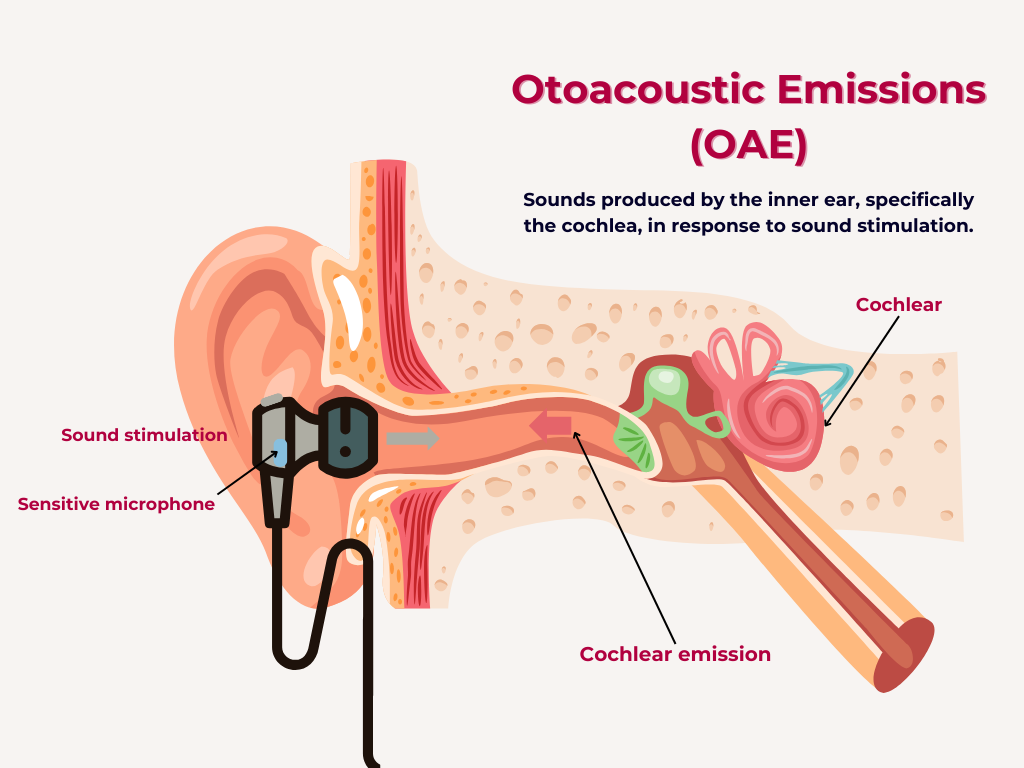Otoacoustic Emissions

Otoacoustic emissions (OAE) are sounds produced by the inner ear, specifically the cochlea, in response to sound stimulation. These emissions are generated by the outer hair cells and can be measured using a sensitive microphone in the ear canal.
Epidemiology
OAE testing is widely used in newborn hearing screening programs and audiological assessments. It's estimated that OAE testing is performed on millions of newborns worldwide each year.
Pathophysiology
Otoacoustic emissions (OAEs) are generated by the outer hair cells in the cochlea. When these cells are damaged or dysfunctional, OAEs may be absent or reduced. Conditions that can affect OAE results include:
-
1. Hearing loss
Sensorineural hearing loss, particularly cochlear damage.
-
2. Middle ear problems
Fluid, infection, or other middle ear issues can affect OAE results.
Otoacoustic emissions (OAE)
Machine and Parts
The OAE machine typically consists of:
1. Probe: Inserted into the ear canal, containing a speaker and microphone.
2. Signal processing unit: Analyzes the recorded OAEs.
Test Performance and Results Recording
The test is performed by:
1. Inserting the probe: Into the ear canal.
2. Presenting sound stimuli: Through the speaker.
3. Recording OAEs: Using the microphone.
4. Analyzing results: The machine analyzes the recorded OAEs and provides a pass or refer result.
Types of OAE
There are two main types:
-
Transient Evoked Otoacoustic Emissions (TEOAE):
Responses to brief sound stimuli.
-
Distortion Product Otoacoustic Emissions (DPOAE):
Responses to two simultaneous tones.
Interpretation in Relation to Hair Cells
OAEs are directly related to the function of outer hair cells. Presence of OAEs indicates normal outer hair cell function, while absence or reduction suggests damage or dysfunction.
Sensitivity of OAE
OAE testing is highly sensitive to cochlear damage, particularly in the outer hair cells.
Limitations of Results
1. Middle ear issues: Can affect OAE results, leading to false positives.
2. Probe fit: Improper probe fit can affect results.
Principles of Newborn Screening and Significance
Newborn screening using OAE testing aims to:
1. Early detection: T Identify hearing loss in newborns.
2. Early intervention: Provide timely treatment and support.
Treatments of Results
Depending on the results, treatment may include:
1. Further testing: Diagnostic testing to confirm hearing loss.
2. Hearing aids: Amplification devices to improve hearing.
3. Cochlear implants: Surgical implants to bypass damaged parts of the ear.
False Positives and False Negatives
1. False positives: Normal hearing, but OAE test fails (often due to middle ear issues).
2. False negatives: Abnormal hearing, but OAE test passes (rare).
There are no specific contraindications for OAE testing.
Understanding the site of lesion
Pure tone audiometry (PTA) and Otoacoustic emissions (OAE) testing can provide valuable information about the type and potential site of lesion in hearing loss.
Here’s how they can help:
Pure Tone Audiometry (PTA)
PTA measures the threshold of hearing across different frequencies, helping to:
-
1. Identify hearing loss:
Determine the degree and type of hearing loss (conductive, sensorineural, or mixed).
-
2. Assess frequency-specific hearing:
Evaluate hearing thresholds across various frequencies.
Otoacoustic Emissions (OAE)
OAE testing assesses the function of outer hair cells in the cochlea. Presence or absence of OAEs can help:
-
1. Determine cochlear involvement:
Presence of OAEs suggests normal outer hair cell function, while absence may indicate cochlear damage.
-
2. Differentiate between cochlear and neural lesions:
If OAEs are present, but PTA shows significant hearing loss, it may suggest a neural lesion (e.g., auditory nerve damage).
Combining PTA and OAE
By combining PTA and OAE results, audiologists can:
-
1. Identify cochlear vs. neural origin:
If OAEs are absent, but PTA shows significant hearing loss, it may indicate a cochlear lesion. If OAEs are present, but PTA shows significant hearing loss, it may suggest a neural lesion.
-
2. Inform treatment decisions:
Understanding the site of lesion can help guide treatment options, such as cochlear implants or other interventions.
Conclusion,
While PTA and OAE testing provide valuable information, further testing (e.g., auditory brainstem response, ABR) may be necessary to confirm the diagnosis and determine the exact site of lesion
Share Post On:
Recent Posts
-
Nuggets of ORL-RHINOLOGY
-
Nuggets of Otorhinolaryngology-Basic sciences
-
Anatomy of the Muscles of the Soft Palate
-
Ethmoidal Arteries Ligation for Epistaxis
-
Submucous Cleft Palate (SMCP)
-
Approach to Ligation of the External Carotid Artery
-
Approach to Managing a 3-Year-Old Boy with a Foreign Body in the nasal cavity.
-
Approach to Managing a 3-Year-Old Boy with a Foreign Body impacted in the ear canal.
-
Endoscopic Sphenopalatine Artery Ligation (ESPAL) for Epistaxis
-
Surgical Management of Epistaxis
-
Technique of Incision and Drainage of Septal Hematoma/Septal Abscess
-
Upper Aerodigestive Tract Foreign Body Impaction
-
Incision and Drainage of Hematoma Auris
-
Rigid Bronchoscopy for Retrieval of Foreign Bodies in Children
-
Foreign Body Impaction in the Larynx, Trachea, and Bronchi
-
Leadership Position is a Tool, not a Trophy
-
Carcinoma of the Oropharynx
-
Peritonsillar Abscess
-
Ethics of Doctor-Patient Relationship
-
Doctor-Patient Relationship Case Scenarios
-
Asymmetrical Tonsils and Approach to Evaluation and Management
-
Nasal Polyposis
-
Rigid Oesophagoscopy and Complication
-
Anatomy of Oesophagus
-
Stridor, Snoring, Stertor And Wheezing: How They Compare
-
Temporomandibular Joint (TMJ)
-
Otoacoustic Emissions
-
Tympanometry
-
Functional Endoscopic Sinus Surgery (FESS)
-
Tracheostomy
-
Clinical Voice Test (CVT) for Hearing Loss
-
Acute Epiglottitis And Approach To Management
-
Synoptic Overview Of Nasopharyngeal Carcinoma
-
Prioritizing Support For People With Disabilities Over Unhealthy Competitions That Marginalise The Downtrodden
-
Otitic Barotrauma
-
Titbits of Informed Consent Process for a Medical or Surgical Procedure
-
Comprehensive Overview of Mpox (Monkeypox)
-
Overview Of Corrosive Ingestion - Acid & Alkalis, and Management Approach
-
Ethical Conundrum
-
Comprehensive Overview of Laryngeal Papillomatosis and HPV Virus
Categories
Get in Touch
Read doctor-produced health and medical information written for you to make informed decisions about your health concerns.

